by TRA
Viewing Aids
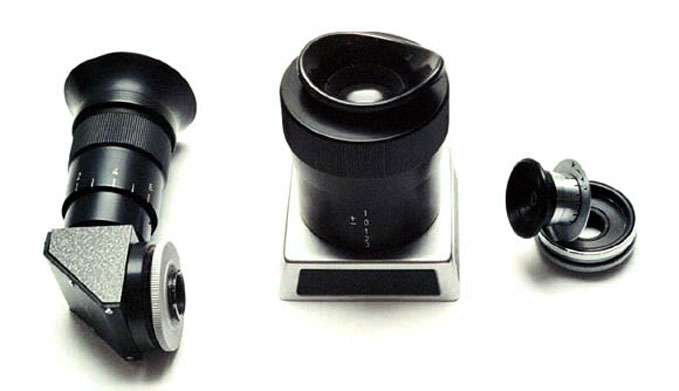
[C309-11: Three viewing aids for the Pentacon Six: the angle
finder, the magnifier head and the magnifying attachment]
Viewing Aids

[C309-11: Three viewing aids for the Pentacon Six: the angle
finder, the magnifier head and the magnifying attachment]
Various viewing aids were manufactured by Pentacon for the Pentacon Six. These are particularly helpful to ensure critical focus with the narrow depth of field that occurs when using bellows or extension tubes. Some of these accessories were subsequently made available in the Exakta 66 finish. While they were cosmetically different, optically they were I believe unchanged from the Pentacon/Zeiss designs.
The angle finder
This can be attached to the metering prism on the Pentacon Six or Exakta 66 to provide more comfortable viewing when the camera is low down or horizontal, as when copying documents or images. It has adjustable diopter correction for the user. This seems to be either optically slightly different with each model, or they have been assembled differently, as correct focus for my eyesight with the Pentacon angle finder is at approximately +0.6, while correct focus for my eyesight on the Exakta 66 angle finder is at approximately +2.9 However, the focussing adjustment in both directions is absolutely enormous, so you are unlikely to encounter a problem, regardless what adjustment your eyesight might need.
See the angle finder on the Pentacon Six in the section on Pentacon Six bellows.
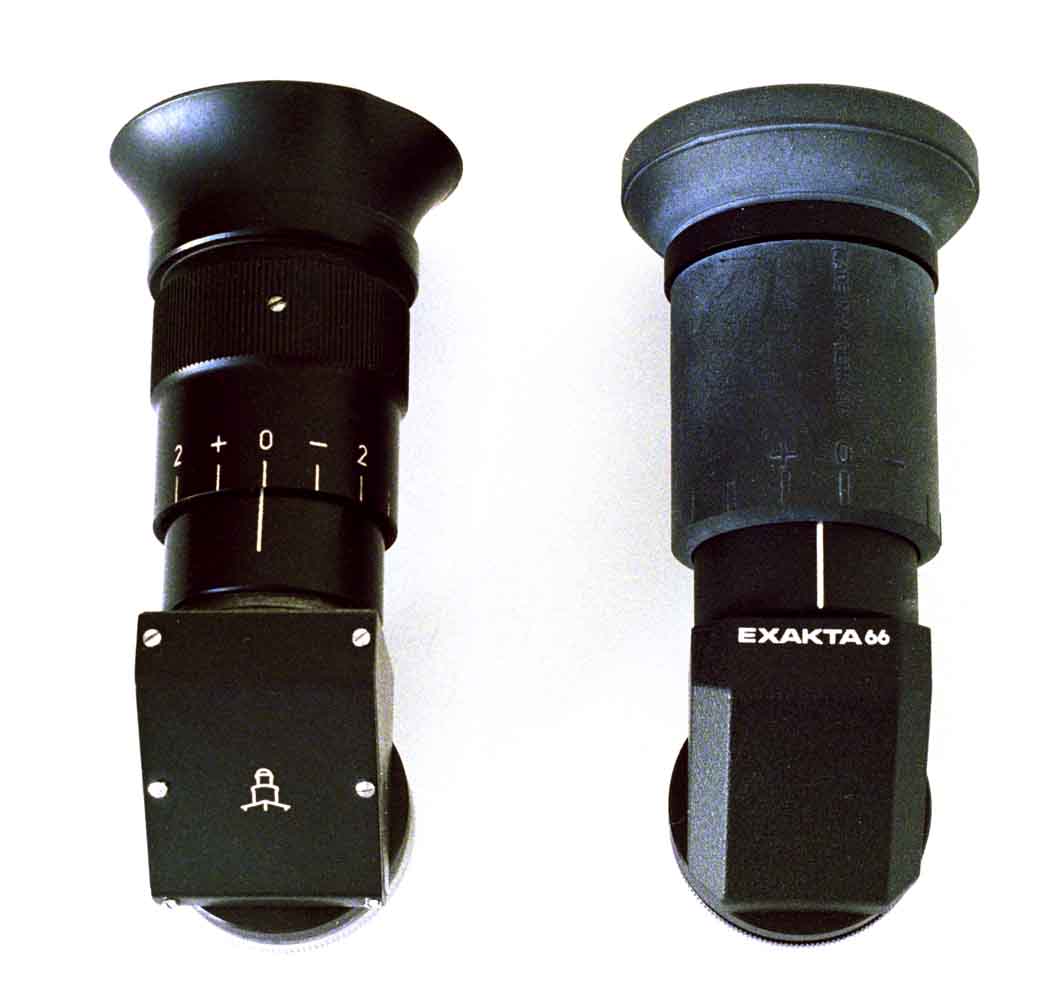
|
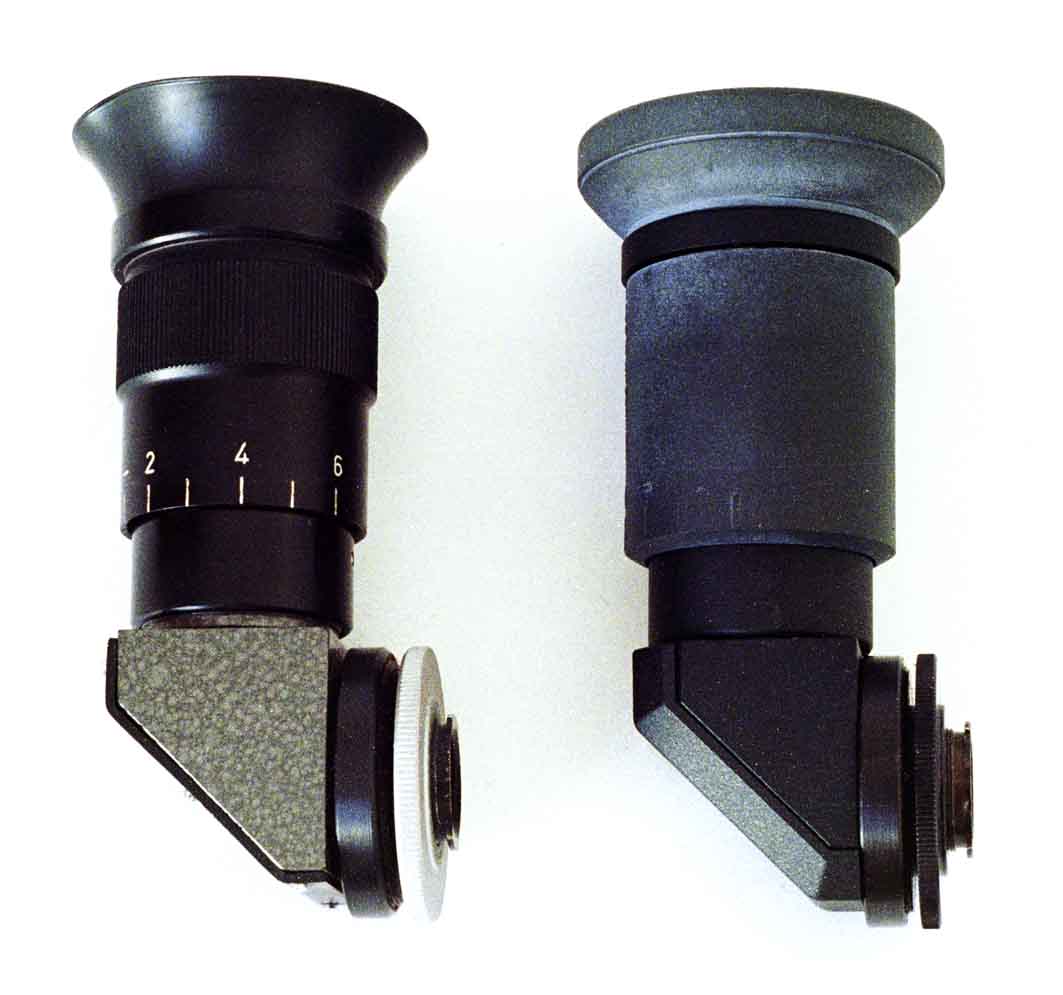
|
On the Exakta 66 TTL prism, the Pentacon Six angle finder’s locking ring may damage the rear surface of the prism, so the use of a small rubber washer is recommended.
“Big ears”
| It is essential that you make sure that any angle
finder, magnifying attachment or eye cup (see below) that
you plan to buy has the “big ears” interface, as these
items were also made with a rectangular interface for use
on Praktica “L series” 35mm cameras (LLC, VLC, PLC, LTL,
L, MTL). (See pictures lower down on this page.)
See the “big ears” arrowed in the image to the right. These can be rotated to bayonet the accessory onto the metering or plain prism. Turning the wheel behind the ears (from this view) then locks the angle finder firmly in place. It can then be rotated to any desired angle. (Obviously, it is not necessary to rotate the magnifying attachment/focussing telescope nor the eye cup.) On some Pentacon Six angle finders, the locking wheel (plain metal in this example and grey in this photo) has been anodized black. Some accessory shoes also use the “big ears” mount. For more details, see the page on the accessory shoes, here. The accessory socket on the Pentacon prisms can be seen
here (scroll down). |
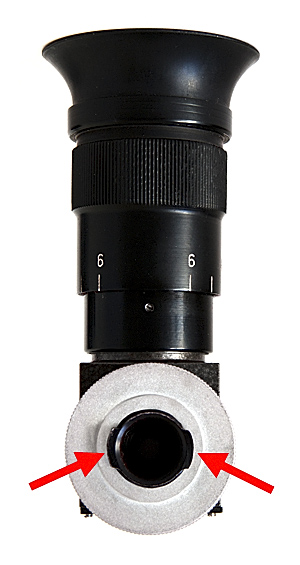
|
The magnifier head
The magnifier head provides a much enlarged image of the whole viewfinder. It also has diopter correction over a wide range. But, of course, one loses the metering, so I prefer the TTL prism plus the angle finder. To see a close-up of this accessory, see the section on Waist Level finders & Magnifying Heads.
The magnifying attachment
This is also called “The Focussing Telescope” in some Pentacon literature. It is designed to be attached to the prism viewfinder, and provides an additional 2.7× enlargement of the central area of the viewfinder image – extremely helpful for precise focussing. As the whole of the frame cannot be seen with the magnifying attachment in place, it can easily be flipped up to check composition. It incorporates adjustable diopter correction for the user.
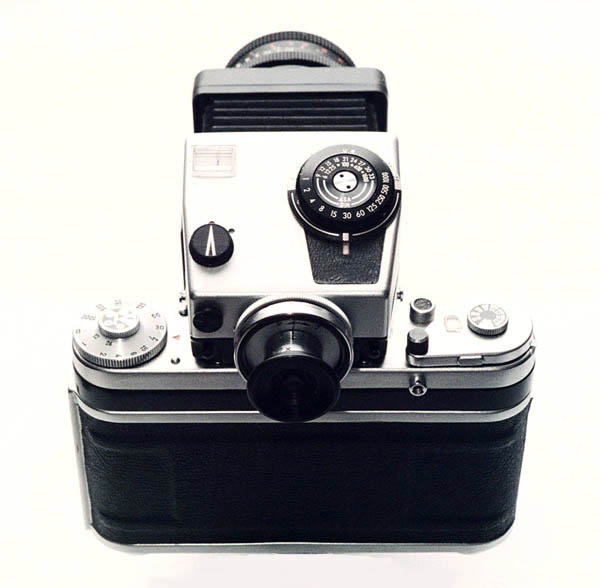
[C309-25: The magnifying attachment in place on the
Pentacon Six TTL prism.
(Note that the Carl Zeiss Jena 80mm Biometar “II” lens has been
used with the Exakta 66 bellows – why not?! They fit!)]
Eye cup
This looks superficially similar to the magnifying attachment,
but the difference is that, as supplied, it contains no optical
components. It merely shields the eye from stray light,
giving a potentially improved view of the viewfinder image.
This item was produced for the Pentacon Six and the Exakta
66. It has the additional advantage that by adding a
dioptric correction lens, available from an optician, spectacle
wearers can view the image sharply without needing their
glasses. The dioptric correction lens needs to be held in
place with a retaining ring that is not supplied with the
eye cup!
 [C372-18A] |
On the left, the Pentacon Six eye cup, on the right, the version produced for the Exakta 66. |
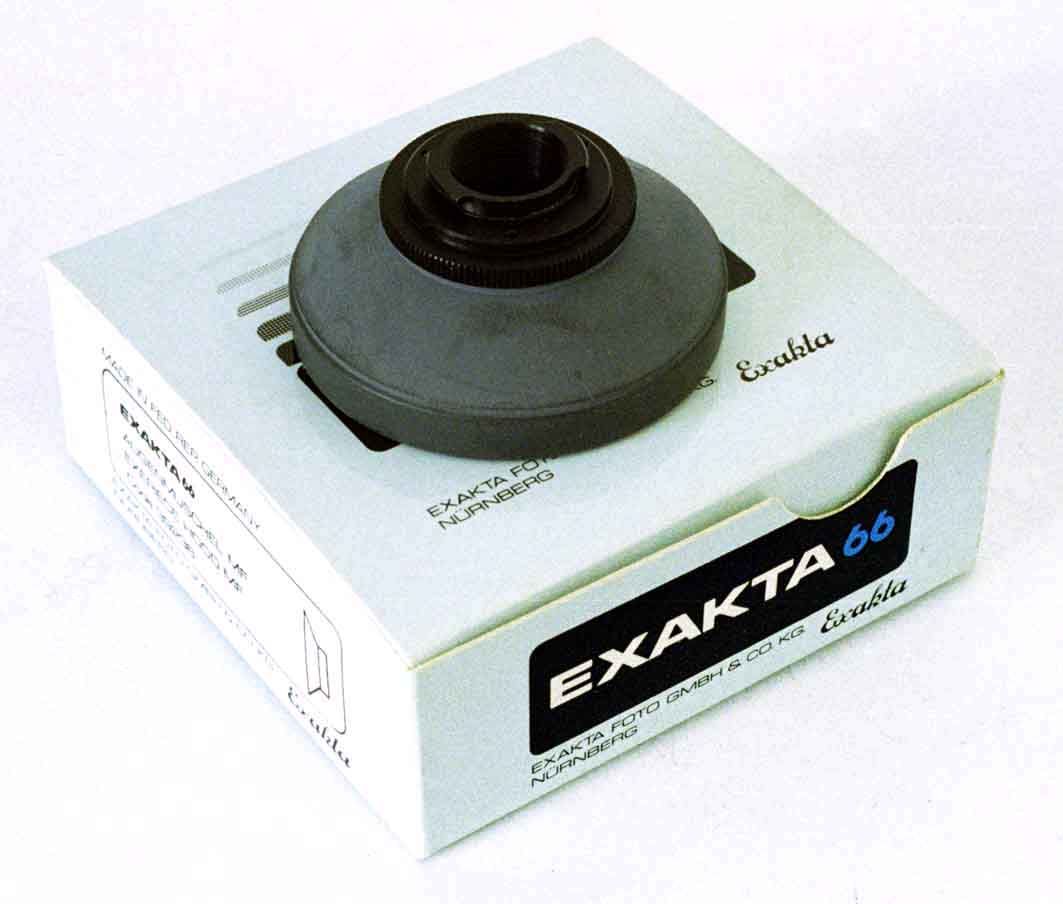 [C372-19A] |
Here we can see the “ears” with which most accessories
are attached to the Pentacon Six and Exakta 66 prisms.
This picture also shows the style of packaging that was produced for Exakta 66 equipment. |
Important! Getting the accessory with the right mount for the prism
The original Pentacon Eye cup was supplied in two versions with
different mounts.
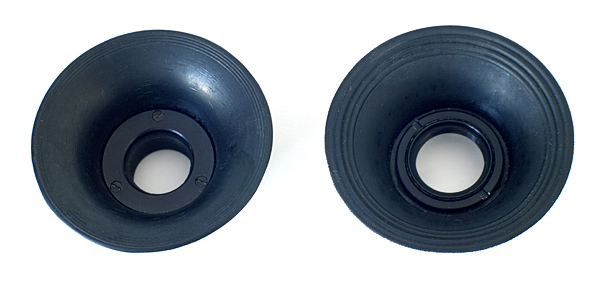 [eyecup01.jpg] |
These two eyecups may appear superficially similar. They are both from Pentacon. But beware! ... |
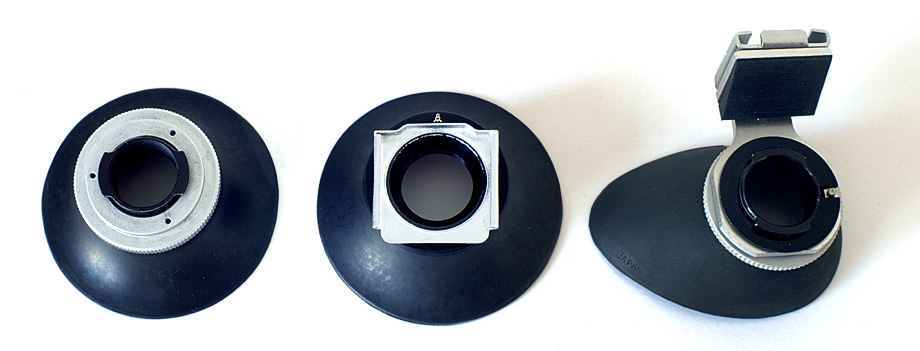 [eyecup02.jpg] |
The one of the left has the “big ears” mount
version for the Pentacon Six. The one next to it has
the rectangular slide-on mount for Praktica L series 35mm
cameras.
If buying an eyecup for your Pentacon Six, make sure that you see the mount - or at least a picture of it. For comparison purposes I have included to the right in this picture the Beroflex (Japanese) combined eyecup and accessory shoe, which is described in more detail here. |
The “big ears” mount version for the Pentacon Six and some other cameras had the Pentacon order number 207070. The version with the rectangular slide-on attachment for the Praktica L series 35mm cameras had the order number 961302.
Focussing screens – Pentacon Six
Pentacon made seven different focussing screens for the Pentacon Six.

[Image from a Pentacon Six brochure dated 1977
From L to R: standard focussing screen, screen with rangefinder
wedges, fresnel screen, then various specialist screens for
reprographics, architecture, etc.]
You can read more about the focussing screens for the Pentacon Six here.
In my opinion, the best general-purpose screen for the Pentacon Six was the Fresnel screen. This increased viewfinder brightness by the equivalent of one stop (the viewfinder image becomes twice as bright), and I used one for over 20 years. With this screen installed, it was necessary to set the film speed on dot on the TTL meter dial, instead of on the usual triangle, to compensate for the extra brightness.
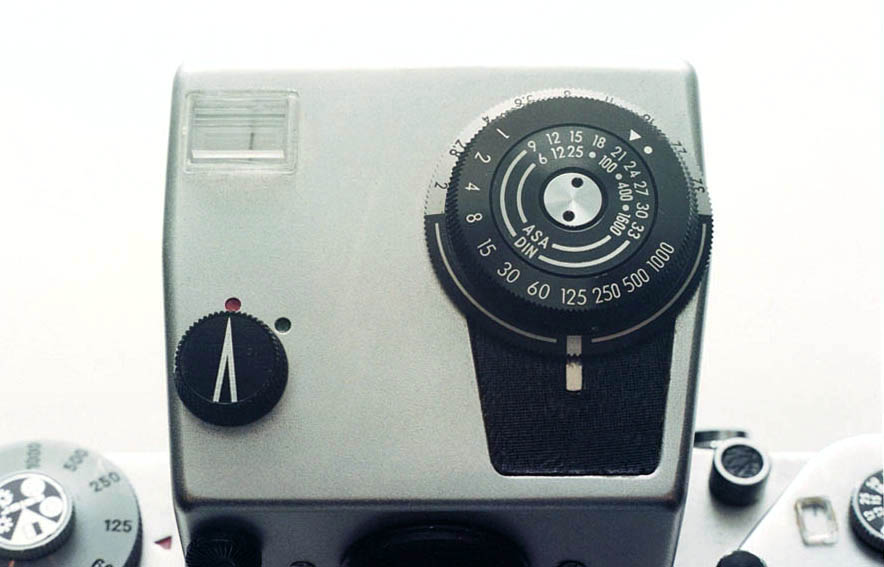
[C311-15: The top of the Pentacon Six TTL finder,
showing the dot and triangle index marks for setting the film
speed.]
The Fresnel Screen
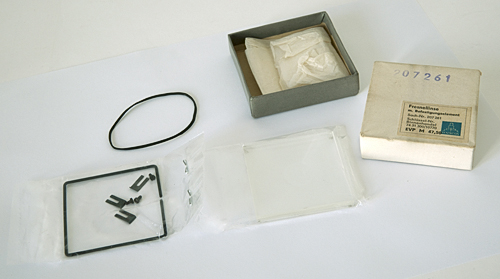 The East German fresnel focussing screen as supplied [fresnel2.jpg] Note that this screen is flat on both surfaces, whereas the standard screen and the other East German screens have a curved upper surface. Therefore, when buying the fresnel screen, make sure that it comes with the correct retaining wire, which has a different shape from the standard wire, and also the three clips that hold it in place (and the corresponding screws). |
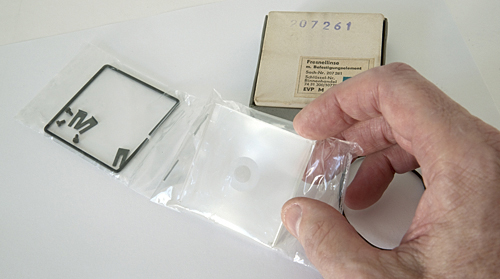 This gives a slightly better view of the focussing aids on the screen. [fresnel6.jpg] |
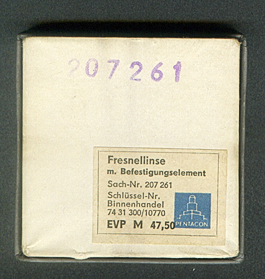 Notice the price: M 47,50. This is East German Marks, and was usually scratched out by East German vendors selling directly to the West (by definition, according to their own communist government’s laws, illegally!). At the unofficial exchange rate of 4 Deutschmarks (West German Marks): 1 Ostmark, the price in DM was a fraction under 12 DM. When the British pound was worth 3.17 Deutschmarks, the price in pounds sterling was a mere £3.78 – an incredible bargain, if you had some way of being able to buy it directly in the GDR. [fresbox.jpg] |
Focussing screens –
Exakta 66
| Three different screens were available for the Exakta 66
Mk I. These were mounted in a black plastic frame in
order to be easily interchangeable by the user.
However, in my opinion the best screen was supplied as
standard. The plastic frame of course masked some of
the image and also made the viewfinder slightly darker.
The Exakta 66 Mk II was supplied with a large and
bright Rollei screen not mounted into any sort
of mask, and in recent years, Pentacon Service in
Dresden have offered to upgrade the Pentacon Six and
earlier models of the Exakta 66 by installing this
screen. I have been very pleased with this upgrade
of both of these cameras. Image brightness is
similar to the original Pentacon Six fresnel screen or
perhaps slightly brighter. During the upgrade
Pentacon adjust the Exakta 66 TTL prism so that correct
readings are given with film speeds set at the same
index point as before. You can see an image of
this screen here. |
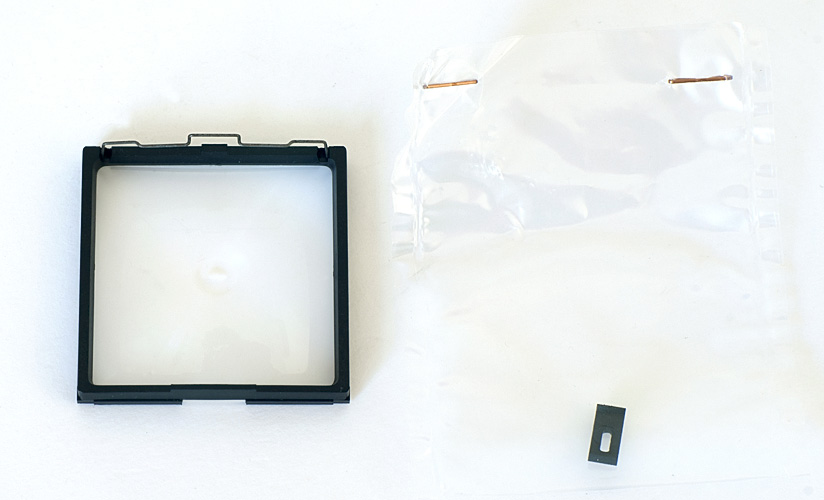 The standard screen supplied with the Exakta 66 Mk I, with rangefinder wedges A retaining clip is to the right. [e66Iscrn.jpg] |
Magnifying lenses for the Exakta 66 Waist-Level Finder
Magnifying lenses were available covering a wide dioptric range for use in the Exakta 66 Waist-Level Finder.

A complete set of the lenses for the Exakta 66 waist-level
finder.
Dioptric values of lenses (from L to R): +2.5, +1.5, +0.5, -0.5,
-1.5, -2.5, -3.5, -4.5
[e66diop02.jpg]
More details concerning these lenses can be found here.
The Kiev 88 focussing
back
Arsenal make a focussing back for the Kiev 88. This can be
mounted on the back of the body in place of a magazine, to check
exact composition and focus. This is particularly useful if
the focussing screen in the top of the body needs to be adjusted
or replaced.

[C311-29: The Kiev 88 focussing back]
Using the Arsenal
Magnifier Head with the focussing back
For more precise checking of focus, the Magnifier Head can be
mounted on the focussing back. This sort of set-up is of
course only useable in a tripod-mounted situation.
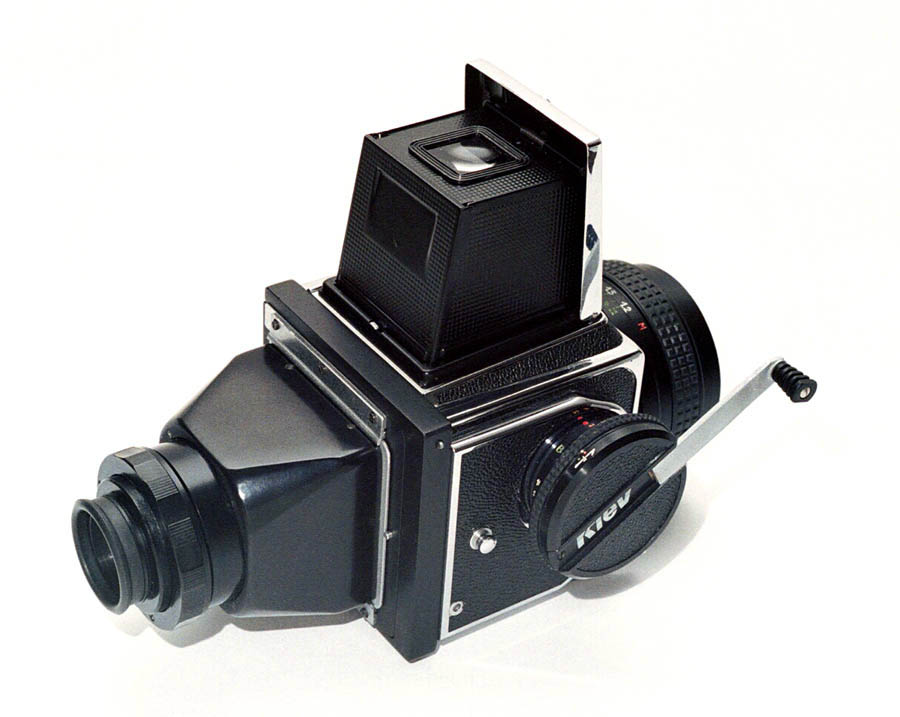
[C311-31: The Arsenal Magnifier Head mounted on the
Kiev 88 focussing back]
Remove the magnifier head and focussing back combination from the camera, and you have a viewfinder for 6 × 6 mounted slides! But on mine internal screw heads jam slides with slim-line plastic mounts, so use with caution.
No Kiev 88 prism, magnifier head or focussing back can be mounted on a Pentacon Six and I do not believe that any adapter exists to make this possible.
To go on to the next section, click below.
Next section (Focussing Screens)
To go back to the beginning of the macro section, click here.
To go back to the beginning of the Accessories section, click
below and then choose the accessory that you want to read about.
Back to beginning of the Accessories section
© TRA February 2002, Latest revision: February 2024